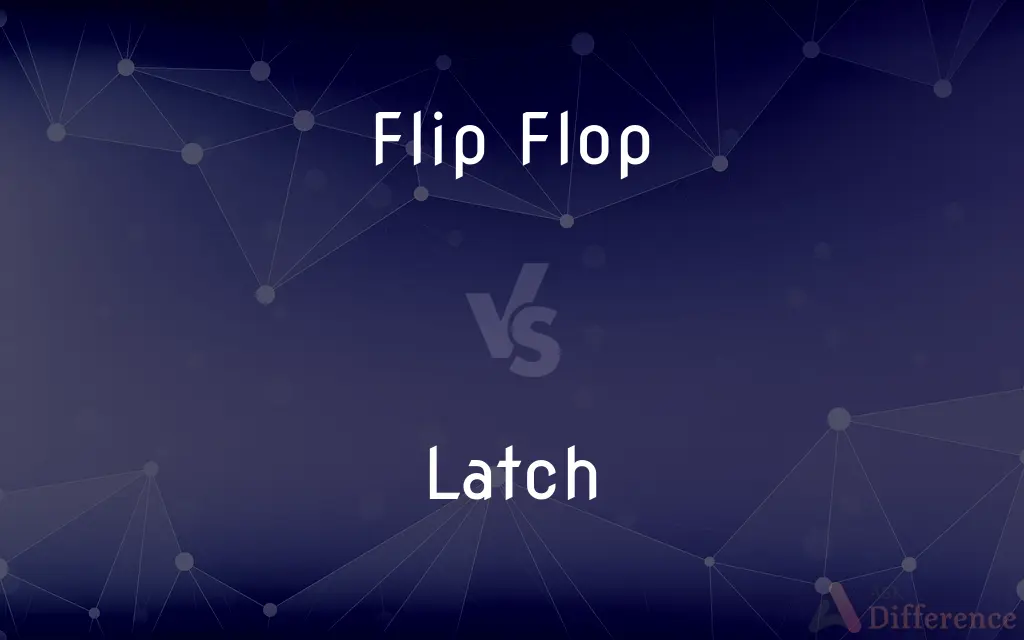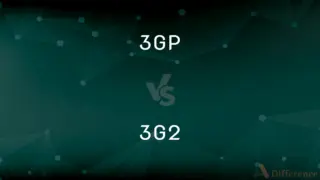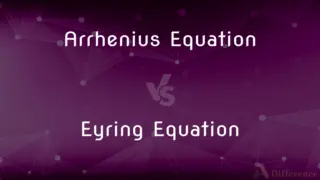Flip Flop vs. Latch — What's the Difference?
By Tayyaba Rehman & Fiza Rafique — Published on February 5, 2024
Flip Flop is a digital memory circuit that stores a single bit of data, changing states only at clock edges, while a Latch is a simpler memory device that changes states with signal levels, without requiring a clock.

Difference Between Flip Flop and Latch
Table of Contents
ADVERTISEMENT
Key Differences
Flip Flops are fundamental components in digital electronics used for data storage and transfer. They store a single bit of binary data and change their state only on the triggering edge of a clock signal. This makes them suitable for synchronous circuits where timing is crucial. Latches, in contrast, are simpler memory devices that can change their state as long as the enabling signal is present, making them level-sensitive and suitable for asynchronous operations.
In terms of complexity, Flip Flops are more intricate than Latches. A Flip Flop is made using latches and includes additional circuitry for clock signal handling, making it a clocked device. This complexity allows Flip Flops to be used in more controlled environments where precise timing is key. On the other hand, Latches, being simpler, are used where such precise timing control is not required.
The way Flip Flops and Latches handle data input and stability differs significantly. A Flip Flop changes its output only at specific intervals (clock edges), ensuring data stability during other times. Latches, however, can change their output whenever there is a change in the input as long as the enable signal is active, leading to potential instability in certain scenarios.
Latches are generally used for simpler storage tasks in digital circuits, like temporary data holding, due to their simpler design and level-sensitive nature. Flip Flops, with their edge-triggered characteristics, are foundational in creating registers, counters, and memory units where precise data handling and timing are necessary.
The choice between a Latch and a Flip Flop depends on the specific requirements of a digital circuit. Latches are suitable for simpler, faster, and less timing-critical operations. In contrast, Flip Flops, being more complex and timing-specific, are indispensable in sophisticated digital applications like data processing and synchronous system design.
ADVERTISEMENT
Comparison Chart
Triggering Mechanism
Edge-triggered (changes state at clock edges)
Level-sensitive (changes state with signal level)
Complexity
More complex, includes clocking mechanism
Simpler design without clock dependency
Usage in Circuits
Synchronous systems (e.g., counters, registers)
Asynchronous systems (e.g., simple data storage)
Data Stability
Stable except at clock edges
Can change state any time enable signal is active
Primary Function
Precise timing control, data processing
Basic storage, temporary data holding
Compare with Definitions
Flip Flop
A type of latch with an added clocking mechanism.
The flip flop is like a latch but with precise control over data storage.
Latch
A simple electronic circuit that can hold a single bit of data.
The latch in the system stores the current state temporarily.
Flip Flop
A circuit element used in timing applications in digital systems.
The flip flop ensures accurate timing in the digital clock.
Latch
A basic memory element in digital circuits, sensitive to signal levels.
The latch changes its output as soon as the input signal changes.
Flip Flop
A digital circuit used to store a single bit of binary data.
The computer's memory uses flip flops to store binary information.
Latch
A device used in electronic systems for basic data storage tasks.
We used a latch to hold the value until the next processing step.
Flip Flop
A bistable device in digital electronics, essential for memory and processing.
Flip flops form the basis of the register in the CPU.
Latch
A bistable multivibrator capable of storing one bit of information.
The latch is a fundamental element in various electronic circuits.
Flip Flop
The movement or sound of repeated flapping.
Latch
A fastening, as for a door or gate, typically consisting of a bar that fits into a notch or slot and is lifted from either side by a lever or string.
Flip Flop
A reversal, as of a stand or position
A foreign policy flip-flop.
Latch
A spring lock, as for a door, that is opened from the outside by a key.
Flip Flop
A backless, often foam rubber sandal held to the foot at the big toe by means of a thong.
Latch
To close or lock with a latch.
Flip Flop
A backward somersault or handspring.
Latch
To have or be closed with a latch.
Flip Flop
An electronic circuit or mechanical device capable of assuming either of two stable states, especially a computer circuit used to store a single bit of information.
Latch
To shut tightly so that the latch is engaged
A door too warped to latch.
Flip Flop
To move back and forth between two conditions or circumstances, sometimes repeatedly
"The weather has flip-flopped between sweltering heat and violent storms" (New York Times).
Latch
To close or lock as if with a latch.
Flip Flop
To reverse a stand or position
"With the board having flip-flopped over zoning issues in the last several years, residents are looking to this fall's election for clarity" (Eugene L. Meyer).
Latch
(transitive) To catch; lay hold of.
Flip Flop
To execute a backward somersault or handspring.
Latch
(obsolete) To smear; to anoint.
Flip Flop
To move from one position to the reverse or opposite
The coach flip-flopped the linemen.
Latch
A fastening for a door that has a bar that fits into a notch or slot, and is lifted by a lever or string from either side.
Flip Flop
A sandal consisting of a rubber sole fastened to the foot by a rubber thong fitting between the toes and around the sides of the foot.
Latch
(electronics) An electronic circuit that is like a flip-flop, except that it is level triggered instead of edge triggered.
Flip Flop
A change of places; an inversion or swap.
Latch
(obsolete) A latching.
Flip Flop
(US) An instance of flip-flopping, of repeatedly changing one's stated opinion about a matter.
Latch
(obsolete) A crossbow.
Flip Flop
A bistable; an electronic switching circuit that has either two stable states (switching between them in response to a trigger) or a stable and an unstable state (switching from one to the other and back again in response to a trigger), and which is thereby capable of serving as one bit of memory.
Latch
(obsolete) That which fastens or holds; a lace; a snare.
Flip Flop
The sound of a regular footfall.
Latch
A breastfeeding baby's connection to the breast.
Flip Flop
A somersault.
Latch
(database) A lightweight lock to protect internal structures from being modified by multiple concurrent accesses.
Flip Flop
A return trip.
Latch
To smear; to anoint.
Flip Flop
To alternate back and forth between directly opposite opinions, ideas, or decisions.
Latch
To catch so as to hold.
Those that remained threw darts at our men, and latching our darts, sent them again at us.
Flip Flop
A decision to reverse an earlier decision
Latch
To catch or fasten by means of a latch.
The door was only latched.
Flip Flop
A backless sandal held to the foot by a thong between the big toe and the second toe
Latch
That which fastens or holds; a lace; a snare.
Flip Flop
An electronic circuit that can assume either of two stable states
Latch
A movable piece which holds anything in place by entering a notch or cavity; specifically, the catch which holds a door or gate when closed, though it be not bolted.
Flip Flop
A backward somersault
Latch
A latching.
Flip Flop
Reverse (a direction, attitude, or course of action)
Latch
A crossbow.
Flip Flop
An electronic component that changes its output state only on a clock edge.
We used a flip flop in the circuit to synchronize data transfer.
Latch
Spring-loaded doorlock that can only be opened from the outside with a key
Latch
Catch for fastening a door or gate; a bar that can be lowered or slid into a groove
Latch
Fasten with a latch;
Latch the door
Latch
An asynchronous storage element in digital electronics.
The latch in this circuit doesn't require a clock signal to operate.
Common Curiosities
How do flip flops and latches differ in triggering?
Flip flops are edge-triggered by a clock, while latches are level-sensitive and triggered by signal presence.
Are flip flops more complex than latches?
Yes, flip flops are more complex, incorporating a clock mechanism.
What is a latch?
A latch is a basic electronic memory device that stores one bit of data, changing state with signal levels.
What is a flip flop?
A flip flop is a digital circuit used to store one bit of data, changing its state with clock edges.
Do latches require a clock signal?
No, latches operate without a clock signal, being level-sensitive.
How does a latch differ from a flip flop in complexity?
Latches are simpler than flip flops, lacking a clocking mechanism.
Can a latch change its state anytime?
Yes, a latch can change its state whenever its enable signal is active.
Can latches be used in timing-critical applications?
Latches are less suitable for timing-critical applications compared to flip flops.
What are flip flops primarily used for?
Flip flops are used in synchronous digital circuits, like memory and processing units.
Where are latches commonly used?
Latches are used in simpler, asynchronous circuit tasks like temporary data holding.
What is the role of a latch in digital circuits?
Latches serve as basic storage elements for temporary data retention.
How do flip flops contribute to data processing?
Flip flops ensure precise timing and control in data processing tasks.
Is a flip flop stable in its output?
A flip flop is stable except at the moments of clock edge transitions.
Are flip flops suitable for asynchronous systems?
Flip flops are primarily designed for synchronous systems due to their clock dependency.
What makes flip flops essential in modern electronics?
Flip flops' ability to provide precise control and timing makes them essential in modern digital electronics.
Share Your Discovery

Previous Comparison
3GP vs. 3G2
Next Comparison
Arrhenius Equation vs. Eyring EquationAuthor Spotlight
Written by
Tayyaba RehmanTayyaba Rehman is a distinguished writer, currently serving as a primary contributor to askdifference.com. As a researcher in semantics and etymology, Tayyaba's passion for the complexity of languages and their distinctions has found a perfect home on the platform. Tayyaba delves into the intricacies of language, distinguishing between commonly confused words and phrases, thereby providing clarity for readers worldwide.
Co-written by
Fiza RafiqueFiza Rafique is a skilled content writer at AskDifference.com, where she meticulously refines and enhances written pieces. Drawing from her vast editorial expertise, Fiza ensures clarity, accuracy, and precision in every article. Passionate about language, she continually seeks to elevate the quality of content for readers worldwide.
















































